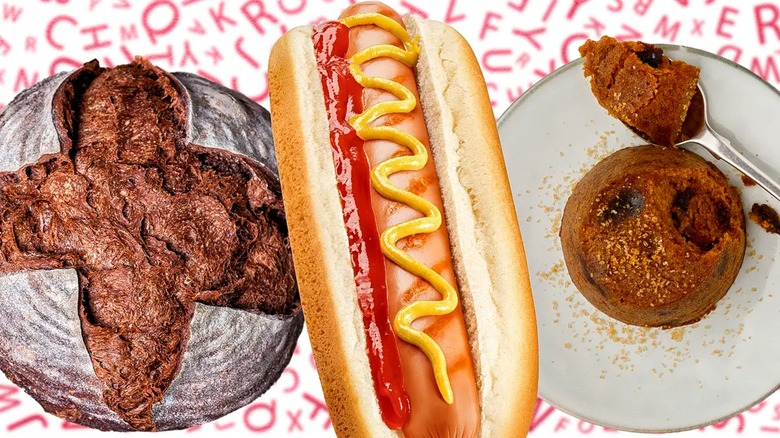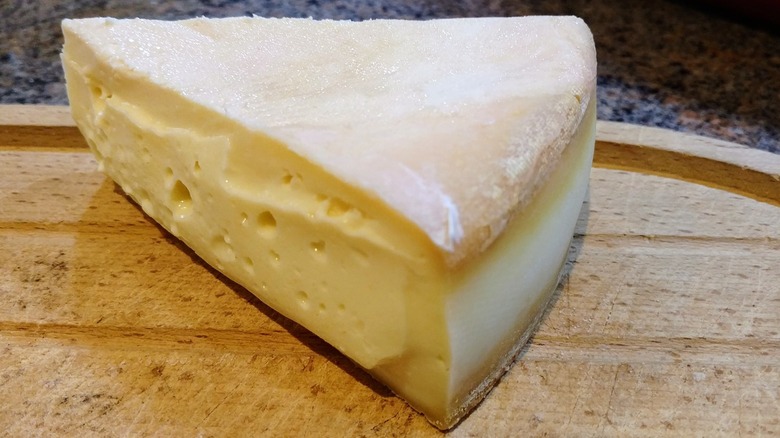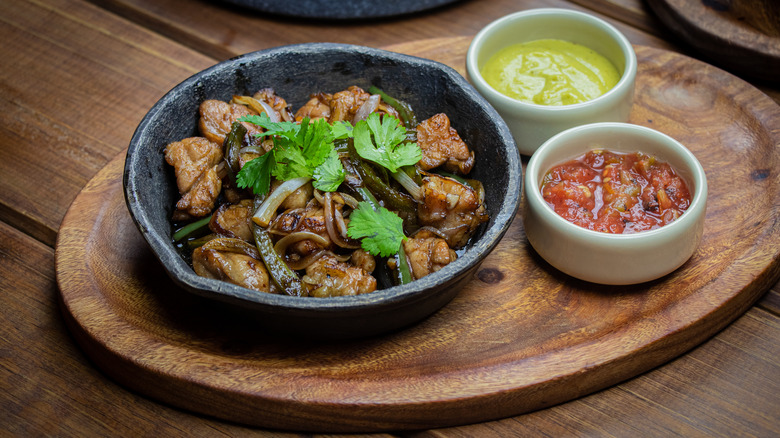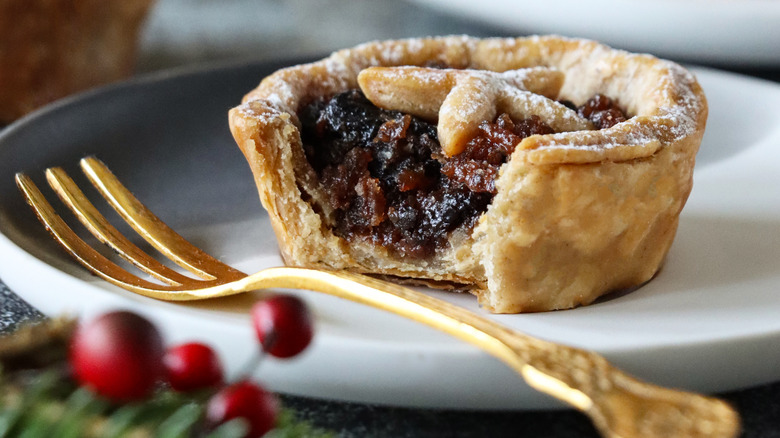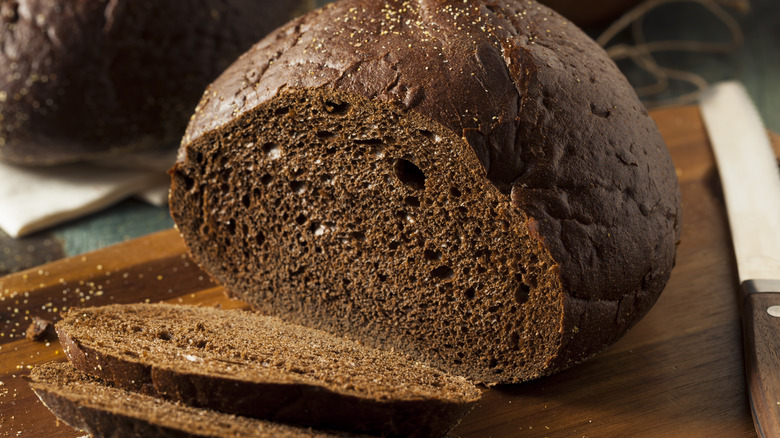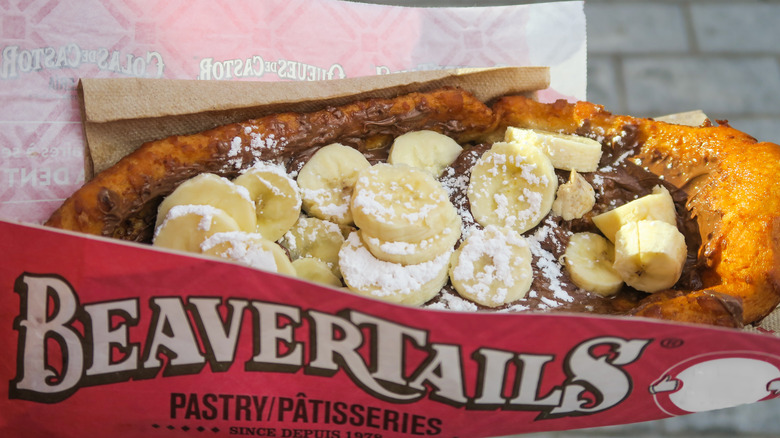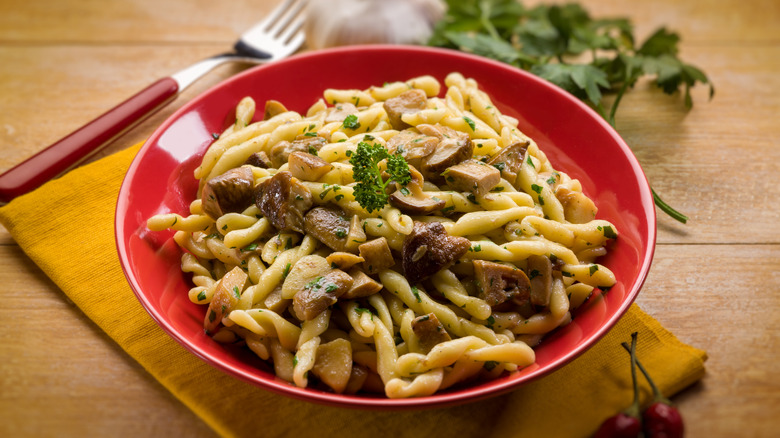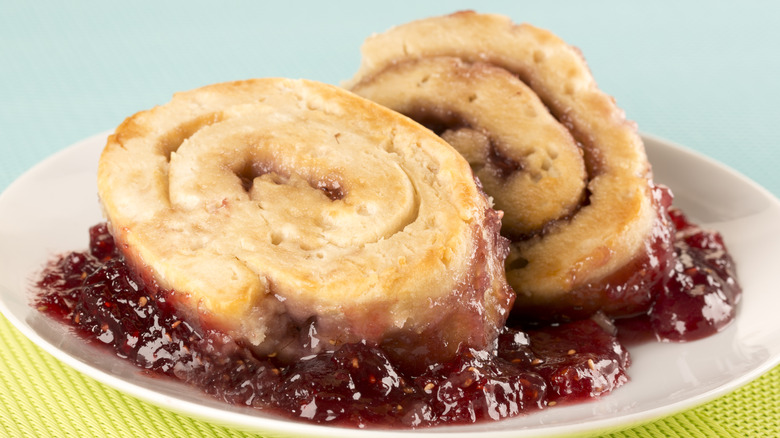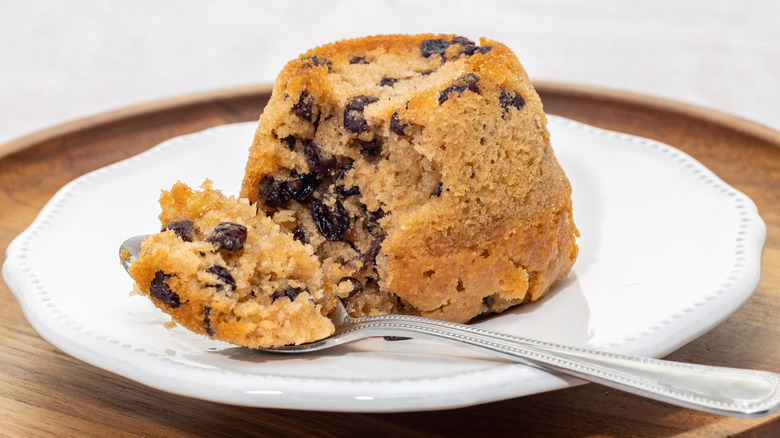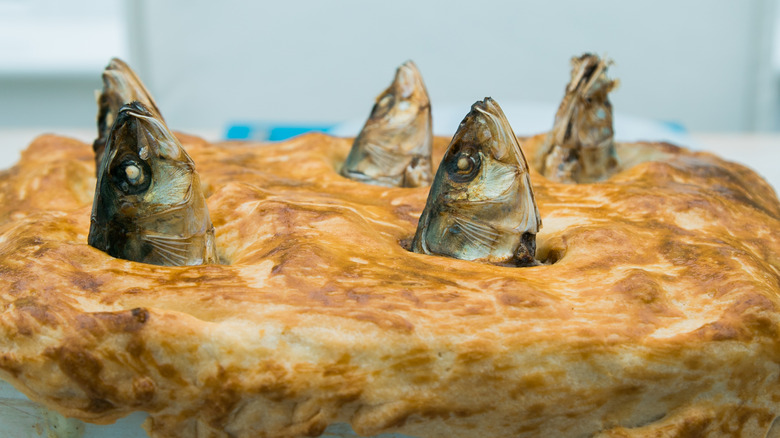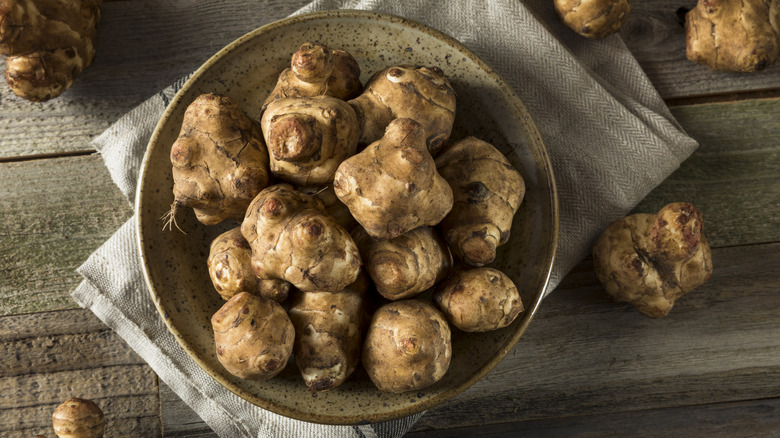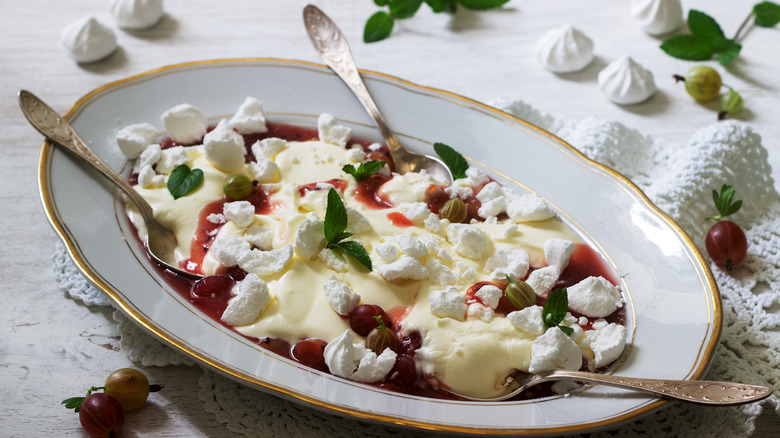How 16 Foods Got Their Unusual Names
Some foods are wonderfully straightforward, with names that are pretty honest about what you're going to be enjoying. Popcorn. Pulled pork. Ice cream. Strawberry shortcake. Other foods ... not so much. In some cases, names give absolutely no indication of what they might be. Sometimes they're wildly misleading, and other times they don't even sound like food at all.
Anyone ordering sweetbreads and expecting a delicious cinnamon-roll-type treat is, of course, going to be wildly disappointed — so why are they called sweetbreads in the first place? Shoofly pie? Well, that just sounds gross, and what about hot dogs? At some point, everyone has to be reassured that no, they're not actually dogs. Dutch baby? Nothing to do with babies.
We wanted to know where some of these bizarrely named foods got their strange names, and why some have gotten the most unappetizing, misleading, and downright strange monikers in the culinary world. And these stories? Well, let's just say that they don't disappoint.
1. Stinking Bishop
Stinking Bishop is, of course, a cheese, and at a glance, the name kind of makes sense. It was once named Britain's stinkiest cheese, but what about the "bishop" part? It turns out, that's a story that's full of equal parts history and hilariousness.
An artisanal cheese popularized by Wallace and Gromit, Stinking Bishop is made with the help of pear cider, and after soaking in the cider, it gains that distinctive smell. It's not just any cider, though. It's made from a variety that's local to the Gloucestershire area — and between 1847 and 1919, one of the area's biggest pear farmers was a man named Frederick Bishop. Did he stink? Yes. In some of the anecdotes told about him, he was stubbornly opposed to bathing, once shot a kettle that was taking too long to boil, and would regularly spend way too much time in town getting absolutely soused.
The cheese itself didn't come about until the 1970s when a farmer with a herd of heritage breed Old Gloucester cows decided to use some old-timey techniques for making artisanal cheese. It was given the same name that the farmer had earned himself so many years prior: Stinking Bishop.
2. Shoofly pie
For anyone who's never had shoofly pie, it's delicious: Imagine a pecan pie without the pecans, and you're there. There are a few different regional versions of shoofly pie, but that's the general idea. Now, the question of the hour is: How did shoofly pie get such a weird name?
Shoofly pie has roots in the Pennsylvania Dutch community, and it originated as a special treat during the centennial celebration of the Declaration of Independence. That was, of course, 1876, and interestingly, there was another Shoofly who was popular at the time. His name was Shoofly the Boxing Mule, and yes, that's exactly what it sounds like.
Shoofly — who was likely named after a song called "Shoo, Fly, Don't Bother Me" — was a mule that had been trained to rear and (while wearing boxing gloves) to "box" with horses. The 19th century was a weird time, and he was so ridiculously popular that he had a whole line of products named after him. Including — so the story goes — shoofly pie.
3. Sweetbreads
First, it's worth mentioning exactly what sweetbreads are. Sweetbreads come from young animals — lambs or calves — and they're two different organs. First, there's the thymus, which plays a vital part in the immune system and produces T-cells, and then there's the pancreas. That's responsible for producing some of the enzymes and hormones crucial for the digestion process. So, why on earth are they called sweetbreads when they're harvested and served together?
Sweetbreads have been served for a long time, and it makes sense: There was a time when none of the animal went to waste. At the time — around at least the 16th century — the Old English term for animal flesh was bræd. Looks kind of like "bread," right? That's one part, but why sweet? These organs might not be sweet to modern tastes, but at the time, it was thought they were much more succulent than other parts of the animal. Hence, sweetbreads.
4. Mincemeat
Mincemeat sounds pretty British, doesn't it? But contrary to the name, mincemeat is typically made with raisins, candied fruit, brandy, a variety of spices ... and all right, there's usually some shortening or suet in there, too. But that's not why the filling is called mincemeat.
The pies date back to the Middle Ages when they were definitely made with finely chopped meat as well as fruit. At the time, the addition of fruit, sugars, and spices would serve to help preserve the meat, which made it a must for travelers during the Crusades. Religious context well-established, they became associated with Christmas during the reign of Henry V, and speaking of weird names, Old English cookbooks actually called them "tarts of flesh." So, it turns out that it can be worse than "mincemeat."
By the Victorian era, the meat was phased out in favor of the sweeter versions that are made today, and some companies — like Walkers — have been using the same recipe since 1899. The meat left, the name stayed, and at least we're not celebrating the holidays with flesh tarts.
5. Pumpernickel
Fair warning: Unless you have nerves of steel and an incredibly mature sense of humor, you're not going to be able to look at a loaf of pumpernickel in quite the same way after finding out just where that ungainly name comes from. The story about how it was named when Napoleon declared it was only fit to feed his horse, Nicol, has been proven to be, without a doubt, not true. Pumpernickel is a German word, and it basically refers to someone who's a jerk. Now, let's look at the word itself.
The first part — "pumpern" — is a bit of onomatopoeia, which refers to words that sound like their meaning. (Think of comic books: "Pow!" "bang!" and "pop!") "Pumpern" refers to a fart, and go ahead, we'll give you a minute. You hear it, right? The second part of the word — "nickel" — is a version of Nicholas, which was often used as a reference to the devil, or Old Nick. In other words? Pumpernickel — a tough-to-digest bread with frequent side effects — translates to the "devil's farts."
6. Whoopie pie
There are a few different explanations as to why the whoopie pie ended up being called a whoopie pie. The one you're going to want to tell the kids is that when enterprising Pennsylvania Dutch bakers created these tasty treats as a way to use the last blobs of cake batter, kids were so excited they'd shout, "Whoopee!" Aw, isn't that wholesome? Now, for the other version of the story.
"Whoopee" dates back to the middle of the 19th century, and yes, it originally meant that wholesome expression of joy. By the 1920s, though, it took on a more adult version of (ahem) joy: In 1928, that was firmly cemented by Eddie Cantor's song, "Makin' Whoopee," which told the story of a newlywed couple, their blissful first nights together, and his ultimate straying, cheating, and (ahem) finding whoopee elsewhere. Whoopie pies seem to have hit the market around the mid-1920s, and it's believed they were given their name in an incredibly cheeky yet brilliant bit of marketing.
7. Hot dogs
Hot dogs have a variety of names. Frankfurter is connected to the dish's origins in Frankfurt, Germany, while "wiener" has been linked to another city of origin: Vienna, or Wien. But hot dog? Exact details of how the term came about have long been lost to time, but it's believed that these summertime favorites were called dachshund sausages — or "little dog sausages" — by the end of the 17th century. Sausages had been around a few hundred years by then, but let's fast forward to America.
That's likely where "hot dog" came into play, and there are a few versions of the story. One suggests a cartoonist drawing New York sausage vendors didn't know how to spell "dachshund" and labeled his drawing "hot dog" instead, but no one's ever been able to find the drawing. The more likely story is that it actually started on college campuses: Vendors selling affordable food to students were called "dog wagons," as a joke about the source of the meat. That — coupled with the long-standing reference to dachshund sausages — came together, and "hot dog" stuck.
8. Beaver tails
Is it possible to go to Canada and not get at least a few beaver tails? Sure, but we wouldn't recommend it. They're just one of many iconic Canadian foods you definitely need to try. At a glance, there's a pretty logical reason for their name: Clearly, they look like the tails of beavers, and Canada has a lot of beavers. Easy, right? There's actually more to it, but yes, the daughter of Pam and Grant Hooker — who popularized the sweet treat — named them after the animal.
Pre-European colonization, beavers — and their tails — were a major food source. They'd be slow-cooked until tender, and the Indigenous peoples shared that with European settlers. Fast forward to the 17th century, when meat-free Fridays during Lent became a regular practice among Roman Catholics. People wouldn't be people if they didn't try to find a way around the rules, and they did: Since beavers lived in water, they were clearly fish, and it was perfectly acceptable to eat them on Friday.
9. Strozzapreti (priest-stranglers)
Strozzapreti is a type of pasta with a name that translates to "priest-strangler." Wait, what? One story simply says that it was so good that there were a few instances of priests eating too fast and choking on it, while another adds an extra layer to the tale: Husbands jealous that their wives were cooking for the clergy would suggest this type of pasta in hopes of choking the priests in question.
That's pretty tame compared to this next story, which says that strozzapreti was made in a time and a place where the Italian people struggled under the oppressive bootheel of the clergy. That clergy demanded complete obedience and acknowledgment of their authority, and while the everyday peasant didn't have many ways to strike back, they did have one thing: Witchcraft.
While making the twists of pasta, it was said that cooks would mutter curses in hopes of imbuing the pasta with the power to kill their oppressive overlords. Local stories were told of curses that claimed the lives of their victims: Greedy priests slurping down noodles that got lodged in their throats. Strozzapreti sent them to meet their maker ... and hopefully, pay for the sins they committed in their worldly lives.
10. Dead man's arm (or leg)
Dead Man's Arm or Dead Man's Leg is more accurately a nickname for a British dessert called a jam roly-poly, and that regular, standard name is both adorable and understandable: It's a dessert that's made by spreading jam on a piece of suet dough, then rolling it. Roly-poly. Straightforward enough, right? The dessert log is then sliced and served, but why on earth would it have such a disturbing nickname?
The dessert isn't baked, but steamed — and once upon a time, it would be wrapped in either an old shirt sleeve or pant leg to hold it together during the process. Pull that out and it would absolutely look like an enterprising cook with admittedly cannibalistic tendencies was getting ready to serve up a severed leg or arm (depending, of course, on the garment of choice). Sounds revolting? Maybe ... or perhaps it's something you should keep in mind for your next Halloween party.
11. Spotted dick
Here's the one that readers have undoubtedly been waiting to learn about, and we won't fail you. Traditional spotted dick has a place on countless lists of weird food names, and it's easy to brush off the "why" as simply, "It's British, what more do you need?" Of course, there's a little more to it. The "spotted" part of the name comes from the use of currants or other fruits, which give it a spotted appearance. So far, so good.
The first mention of spotted dick comes from a mid-1800s book called "The Modern Housewife," and it's believed the name is connected to the much older tradition of serving up meat puddings. "Pudding" was once "puddink," which may have been connected to the word "dick" as a reference to a type of cheese. "Puddink" plus cheese plus treacle sauce somehow became "treacle dick," and when the currants made the whole thing spotted, well, here we are. Giggling.
12. Stargazy pie
Stargazy pie gets that rather romantic name from the fact that fish heads baked into the top crust are positioned to stare up at the sky — to stargaze, as it were. The pie is traditionally only served on one night: December 23. Why? According to the story, that's when a 16th-century fisherman named Tom Bawcock headed out into the storm-torn sea off the coast of the Cornish town of Padstow, determined to brave the weather and bring fish back to a village that was starving during a particularly long, hard winter.
Bawcock's fishing trip was so successful that it saved the lives of those in the town, and when he returned with his catch, enterprising cooks baked fish pies with the heads poking out. Why? To prove that he really had been successful and that they would not starve. It's weird and sweet at the same time, especially considering the town has a history of weathering catastrophic disasters in the rough, unpredictable coastal waters.
13. Dutch baby
Dutch babies are pancakes, but Dutch pancakes are called pannenkoeken, so what is a Dutch baby? A baby pancake that's part crêpe, part popover. Confused? Good! We're not done yet.
Dutch baby pancakes are actually German, and they came to the U.S. thanks to a Seattle diner called Manca's. Manca's closed in the 1950s, and in an interview (via HeraldNet), Mark Manca explained that they had put the light, fluffy, sweet dish on the menu because it was incredibly easy to make a lot of them in a short amount of time — and they needed something quick to deal with the turnover. They were such a staple that Manca's trademarked their Dutch babies, but where did the name come from?
It was a misnomer: When the diner owner's daughter put them on the menu, she likely translated Deutsch into Dutch, instead of sticking with the dish's original roots. The mistake stuck, and Dutch babies were born.
14. Jerusalem artichoke
Here's an incredibly deceptive name: The Jerusalem artichoke is not an artichoke at all, it's a root vegetable that actually belongs to the sunflower family. It's not from Jerusalem, either, so what gives?
First, the "Jerusalem." There are a few theories as to how the name came about: In one, it's a mistranslation or misinterpretation of the Italian word for sunflower, which is "girasole". In another, it was thought that when this plant — native to North America — was introduced to Europe, it was described as having come from the "new Jerusalem." At the time, it was introduced in French kitchens and used in a dish called purée Palestine by a chef who thought the plant was an import from the original Jerusalem.
Why is it called an artichoke? Simply because of how it tastes, which means that it's occasionally seen on menus as a sunchoke. Fun fact: Jerusalem artichokes are the main ingredient in one of "Top Chef" judge Gail Simmons' favorite dishes.
15. Eton Mess
Eton Mess is unsurprisingly British: It was named after the place where it reportedly originated, which is Eton College. So far, so good ... but why on earth would anyone decide to call this fruity dessert a mess?
It's kind of hard to tell because the most oft-told tale — that an unruly dog destroyed a perfect strawberry pavlova, and the resulting dessert was dubbed a mess — is dated to the 1920s. The problem? Eton Mess had been around since at least 1893. That said, there are a few different ideas about why it's called a Mess, and only one has to do with the traditionally messy appearance of the dish.
Another theory says that it's a version of the Latin word "missum," which simply refers to a portion of a particular dish. Interestingly, there's a contingent of very passionate dessert connoisseurs that insist that it's wildly incorrect to call it an Eton Mess and insist that "mess" should be preceded by the fruit that's in it. Regardless, it continues to be identified with Eton College, as it's served there in honor of King George III's birthday and during annual cricket matches. (Want to try Eton Mess at home? It's incredibly easy to make.)
16. St. Agatha's breasts
One glance at the marzipan-covered pastries known as St. Agatha's breasts and it's pretty clear just why they're called that. But the full story behind this Sicilian pastry is going to get very dark very quickly. St. Agatha was one of many medieval saints, and like many, she paid a price for her beliefs. By the time she was 15, she had decided that she wanted to live a life of purity and chastity, dedicated to her faith. This was the year 251, though, and the powers-that-be in Catania didn't like that. She was tortured, dragged over hot coals, and her breasts were cut off: When she's depicted in paintings, she's easily identifiable because she's holding her severed breasts on a tray ... and they look unnervingly similar to the Sicilian pastries that are named for her.
Agatha perhaps predictably died at the hands of her torturers, but pastries? Why? They're meant to be a symbol of the feminine that helped bridge the gap between Christianity and pagan goddess worship.
